Abstract
This study aimed to investigate a techno-economic evaluation of the photovoltaic system, along with a diesel generator as a backup supply, to ensure a continuous twenty-four hours power supply per day, no matter the status of the weather. Healthcare centers in Bangladesh play a vital role in the health issues of the residents of rural areas. In this regard, a healthcare center in Baliadangi—Lahiri Hat Rd, Baliadangi, Thakurgaon, Bangladesh, was selected to be electrically empowered. The simulation software Hybrid Optimisation Model for Electric Renewables (HOMER) and the HOMER Powering Health tool were used to analyze and optimize the renewable energy required by the healthcare center. It was found that the healthcare center required a 24.3 kW solar PV system with a net current cost of $28,705.2; the levelized cost of electricity (LCOE) was $0.02728 per kW-hours, where renewable energy would provide 98% of the system’s total power requirements. The generator would provide 1% and the grid would supply the remaining 1%. The load analysis revealed that the hybrid PV system might be superior to other power sources for providing electricity for both the normal function and the emergencies that arise in healthcare’s day-to-day life. The outcome of the study is expected to be beneficial for both government and other stakeholders in decision-making.
1. Introduction
Health is a basic human requirement, which is widely viewed as a measure of human progress. However, there are some difficulties in providing proper health facilities in developing countries, such as Bangladesh, since the majority of people live in rural areas [1,2] where healthcare centers are the main source of obtaining health-related services. In rural areas of Bangladesh, the Upazila health centers provide various primary healthcare services, such as in-patient treatment, out-patient treatment, family planning, and other basic healthcare facilities for rural people [3,4]. To provide these facilities, the Upazila health centers need a continuous power supply. However, the energy crisis, particularly in the Upazila healthcare centers of Bangladesh, is one of the most significant difficulties concerning the country’s future [5,6].
Every day a substantial quantity of load shedding is caused by a lack of power generation. It has been reported that health facilities without electricity serve an estimated 1 billion people worldwide [7]. Medical instruments, such as ultrasound, autoclave, centrifuge, and x-ray machines could not be utilized in such locations due to this deficiency. Surgical procedures are sometimes aided by natural light from windows or hurricane lamps used at night [8]. According to reports, the death of women occurs every day around the world during pregnancy and childbirth, due to a lack of competent medical treatment, and providing minimal illumination and operable equipment would cut mortality rates by 70% [9]. To address all of these issues, numerous countries, throughout the world, have expanded the use of photovoltaic energy to include healthcare services in rural and remote places [10,11].
Al-Karaghouli et al. [12] evaluated the requirement for a Photovoltaic solar panel to provide electricity to health centers in isolated areas in southern Iraq. The scholars utilized HOMER software to assess the most cost-effective method. They presented a scheme with a daily load of 31.6 kW-hours that consists of 6-kW photovoltaic panels, a 3-kilowatt inverter, and 80 batteries. The system’s total initial cost was 50,700 US dollars, the net current cost was 60,375 US dollars, and the electricity production cost per unit was 0.238 US dollars. Santosh et al. [13] analyzed the delivery of energy to the entire hospital building at the Gauri maternity home in Ramkrishna Puram Kota Rajasthan, India. They proposed a system of 10.6 kW that consists of a total of 32 solar panels. The net present cost was approximately 6.5 lakhs Indian Rupees. Ajao K et al. [14] suggested a system that included a (0.05–0.4 kW) PV panel, a (0.1–1.5 kilowatt) converter, a (200 Ah/12 V) battery, and a (0.4 kilowatt DC) FD series wind turbine. The authors’ optimization result showed that the primary capital cost and an annual operating cost were 3455 USD, and 69 USD, respectively. The NPC was 4251 USD, with a cost of energy (COE) of 1.74 USD per kilowatt-hour. The hybrid system, according to the authors, had a pay-back period of around 33 years at the present cost. Maliha et al. [15] studied the best off-grid energy system for satisfying the load demand of a rural Bangladeshi community. The levelized cost of this system was 0.21 USD and the total net present cost was 4.8 million USD. Muyiwa et al. [16] studied the PV and biodiesel generator-based hybrid energy system for fulfilling the domestic electricity, as well as the water of rural people in Ghana. They observed that, through this system, the beneficiaries had to pay almost double, i.e., it was not cost-effective. In that case, to get a cost-effective system, more research has to be performed. The aforesaid researchers were focused on the best design and planning of on-grid or off-grid solar photovoltaic systems [17,18,19]. For the on-grid solar system, one of the disadvantages is that during a blackout, this system is unable to generate electricity. It cannot generate solar energy at night or when there is no sunlight [20,21]. For the systems with off-grid solar modules, some disadvantages occur; this is off-grid systems necessitate the purchase of a backup battery, which can be expensive and complex, and solar battery systems must be maintained regularly. [22].
A techno-economic analysis of a hybrid system that powers a school in Misurata, Libya, was provided by Glaisa et al. [23]. To assess the various configuration alternatives for supplying the electrical load, the HOMER optimization model was employed [23]. On a 23-hectare farm on Camotes Island in Cebu, Querikiol et al. evaluated the efficacy of a 1.5 kW micro-off-grid solar power generator [24]. The HOMER optimization program was used to establish the best configuration for the micro-off-grid system. The best option was a 2.63 kW all-PV system with 8 kWh of batteries [24]. Aisa et al. studied the viability of building a solar-wind hybrid power plant to supply the general hospital in Sabratha with electricity [25]. HOMER was used to optimize and simulate the proposed system.
In this study, a hybrid photovoltaic system was considered, where the diesel generator would be employed as a backup supply to minimize the initial cost and overcome the blackout problem. When the proposed system was connected to the electrical grid, the system would operate as an on-grid power system, and it would operate as an off-grid power plant for sites that were entirely isolated. If the PV generation was insufficient, the diesel generator would be employed as a backup supply.
Many papers have been published on renewable energy simulation using HOMER. However, this is the first attempt to simulate a hybrid PV system and perform a techno-economic analysis in order to find the optimum way to power the health center in the Baliadangi Upazila health facility in the Thakurgaon district in Bangladesh. The objectives of this study were to select a site and calculate its total load, simulate the best possible combinations of power supply options to satisfy the electrical loads of a healthcare institution at the lowest possible cost, and analyze the generation from a technical and financial perspective.
2. Research Methodology
2.1. Site Selection
For the techno-economic assessments, the Baliadangi Upazila health care was considered. Figure 1 depicts the location of the chosen medical facility on a Google map, showing the site’s location in Baliadangi—Lahiri Hat Rd, Baliadangi, Thakurgaon, Bangladesh [26].
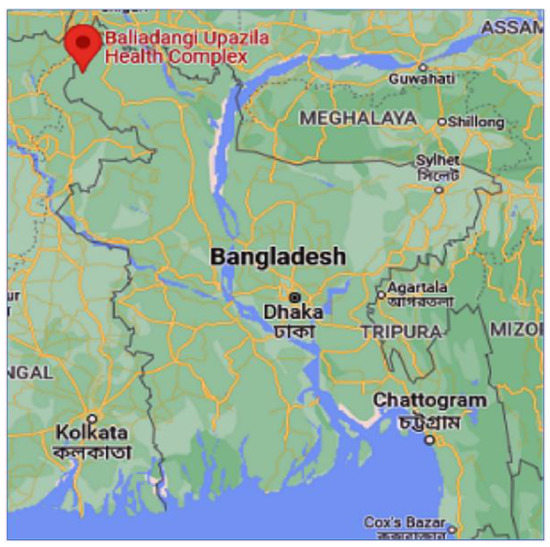
Figure 1.
Site location of Baliadangi Upazila health complex.
2.2. System Optimization Tool
The HOMER Powering Health Tool is a free online model for creating preliminary designs of electric power systems for healthcare institutions. The tool is designed for engineers, financiers, and project managers in the energy sector to improve the implementation of such systems. Based on the supplied inputs, the tool simulates the best possible combinations of power supply options to satisfy the electrical loads of a healthcare institution at the lowest possible cost. It analyzes several configurations of solar photovoltaic (PV) [19,27], diesel, gasoline, or propane-powered generator sets, batteries (lead-acid or lithium-ion), and grid electricity. No registration or software download is required to use the model, which is online and can use an infinite number of times [28,29,30]. The National Renewable Energy Laboratory in the United States created HOMER Pro, a software application. This software application is used to develop and analyze off-grid and on-grid power systems for far, stand-alone, and distributed generation applications from a technical and financial perspective.
2.3. Design Specifications
A photovoltaic (PV) system, an inverter, a diesel generator, net metering, and the required loads all are parts of the system. A schematic diagram has been displayed in Figure 2. In this hybrid power system, the main grid and the loads are linked to the AC bus. A photovoltaic power system and an energy storage device are linked to the DC bus. For bidirectional energy transfer, a bidirectional energy converter links the DC bus with the AC bus. The DC bus does not currently supply any loads, but in the future, it might be able to supply some loads, such as the hospital’s UPSs. A photovoltaic power system, a diesel generator, a converter, a grid, and load components make up the hybrid photovoltaic system. PV modules use solar radiation to create DC electric power. PV modules are used to supply the output power. Diesel generators are used as backup energy sources when there is no access to the grid or when there is a disturbance in electrical power. A bidirectional power converter inside the system transfers energy from the AC bus to the DC bus. The converter functions as both an inverter and a rectifier, depending on the system’s requirements for energy consumption, production, and storage. The power required by the hospital complex is the only load In this design. The load’s data has been gathered from the area.
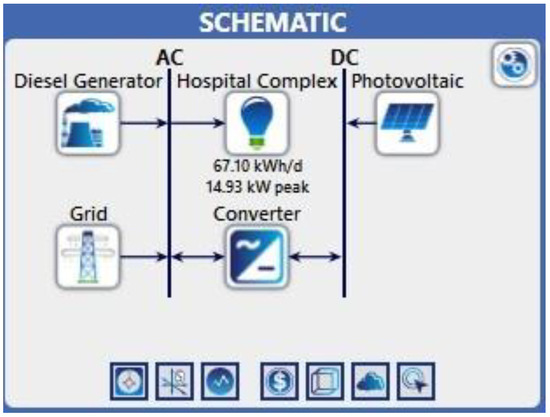
Figure 2.
Schematic diagram for the proposed system.
In this study, the Cheetah HC 72 M, 400 Wp, MONO PERC HALF CELL MODULE was used. Table 1 shows the technical specifications of the chosen Photovoltaic [31] where the module efficiency was 19.88%, and the tracking system was fixed.

Table 1.
Technical specification of the solar panel.
Table 2 shows the component size and cost considered for the analysis, where the capital cost of the PV panel, converter, and diesel generator was $590 per kilowatt, $140/kW, and $ 160/kW, respectively; the derating factor of this PV panel was 80%.

Table 2.
List of system component sizes and costs considered for the analysis.
3. Results and Discussion
3.1. Estimation of Load Requirements
The overall electricity consumption by the various loads of the hospital can be used to compute the electric power demand. The load demand was calculated by conventional mathematical criteria by using Refs. [32,33]. Table 3 shows the load computation for a weekday with a higher load demand during the summer. The average power usage was roughly 67.1 kWh per day, according to the data collected from the various units of the healthcare center.

Table 3.
Healthcare load analysis.
3.2. Load Profile
The Baliadangi Upazila health complex is a government healthcare center, consisting of healthcare facilities, an administrative building, and housing for health experts and support workers. The medical facilities offer both a general ward and emergency services that are available around the clock, as well as eight-hour outpatient, surgical, and analytical services. Additionally, various wings, including hospital administration, outpatient centers, surgical centers, etc., are open at 8 AM and close at 5 PM. Therefore, the greatest quantity of electric loads is ON at that time, as shown in Figure 3. Depending on the weather variation, load requirements are varied from January to December. Figure 4 illustrates the seasonal load profile variation of the healthcare’s hybrid PV system.
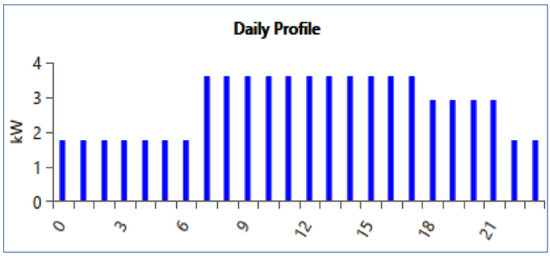
Figure 3.
Daily load profile.

Figure 4.
Seasonal load profile.
3.3. Solar Energy Resources
The monthly mean global solar radiation data can be obtained using HOMER software giving the longitude and latitude of the selected site. Figure 5 illustrates the horizontal solar radiation spans from 4.02 kW/m2/day to 6.27 kW/m2/day; in addition, the clearness index spans from 0.38 to 0.679, and were found for the Baliadangi area, with a scaled annual average value of 4.85 kWh/m2/day. The maximum and minimum levels of solar radiation were recorded in April and September, respectively. The levels of solar insolation at Baliadangi show the capacity for the established order of PV technology, in comparison to other relevant regions across Bangladesh.
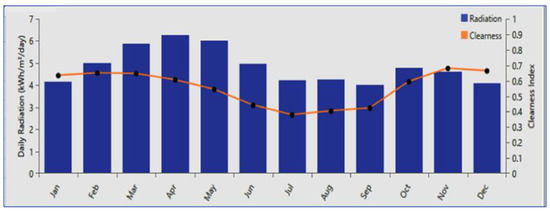
Figure 5.
Monthly average horizontal global solar irradiation.
3.4. Optimization Results
Figure 6 has depicted the optimum options (from an economical point of view) for each system architecture. This study used a PV/generator/grid combination. In the fourth-row combination, the generator is not implemented, and in other row combinations, one or two components are missing; however, in this study, selected combinations of all components have been implemented, as this was the optimal combination of sources. Based on solar radiation of 4.85 kWh/m2/day, these optimization results were obtained:
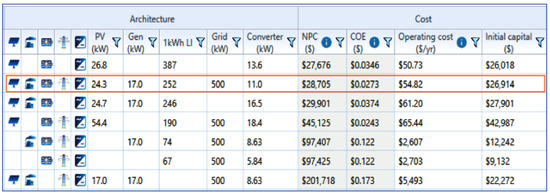
Figure 6.
Optimization results.
The grid, 24.3 kW PV panels, a 17 kW generator, and an 11 kW converter are the most cost-effective combination, as shown in Figure 6.
As shown in Figure 7, the initial cost of hybrid PV system elements, maintenance costs, and overall costs throughout the 25-year project have been depicted where the Autosize Genset, PV, Grid, converter, and other component costs were $2413.76, $14,349.12, $777.71, 2767.5, 8314.79, respectively.

Figure 7.
The cost summary for the optimal system.
The cash flow for the suggested system’s 25-year period of operation is shown in Figure 8. The initial investment was $26,914.32. A replacement cost of $1538.36 would be required after 15 years. The system would gain a saving of $2594.49 at the close of the 25 years.
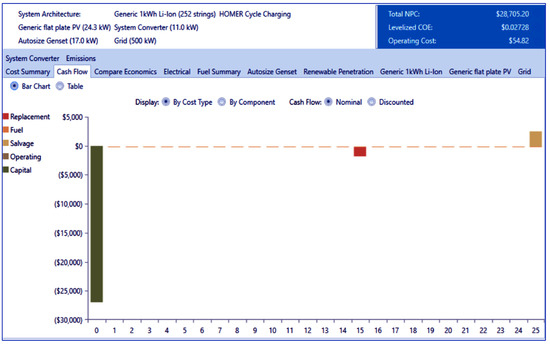
Figure 8.
Cash flow order for the proposed system.
Figure 9 shows the monthly electric production for the system, where the total energy production was 38,866 kWh/year, where the generic flat-plate PV was provided by 38,330 kWh/year, the Genset generator was provided by 309 kWh/year, and the grid purchased 227 kWh/year.
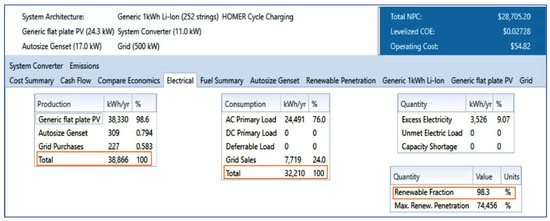
Figure 9.
Monthly electric production for the proposed system.
Figure 10 shows the PV power output for the optimal system for the whole year, where the rated capacity, means output, and capacity factor was 24.3 kW, 4.38 kW, and 18%, respectively. PV production began around 7 AM and ended around 5 PM.
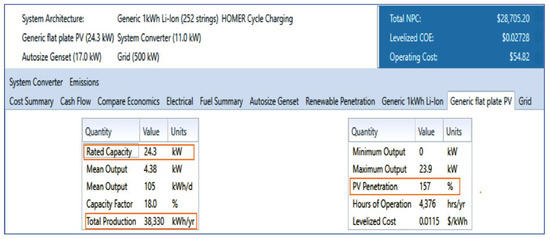
Figure 10.
PV power output.
Figure 11 shows the total energy purchased from the grid and the total energy sold to the grid, where 227 kWh per year of energy was purchased from the grid, and 7719 kWh per year of energy was sold to the grid.
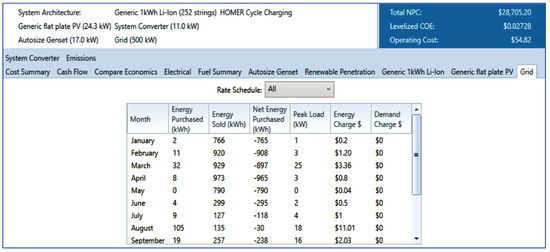
Figure 11.
Grid for the system.
Figure 12 shows the system inverter output and rectifier output, where the inverter output capacity, mean output, maximum output, and capacity factor were 11 kW, 3.66 kW, 11 kW, and 33.3%, respectively; it also shows that the rectifier output capacity, mean output, maximum output, and capacity factor were 11 kW, 0.0374 kW, 11 kW, and 0.341%, respectively. The electricity production cost per unit is determined by the formula below (Equation (1)):
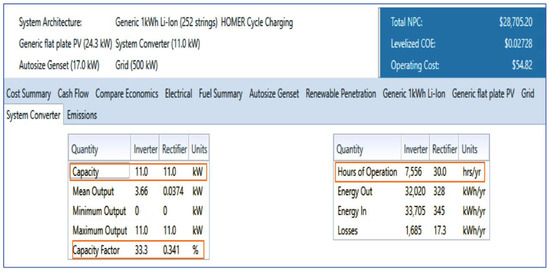
Figure 12.
System converter for the system.
Equation (1) gives the value of the electricity production cost per unit for this proposed system, as is shown below:
Figure 13 shows the pollutant emissions produced by the whole system operation, where the emissions of CO2, CO, SO2, unburned hydrocarbons, particulate matter, and NOx were 399 kg/year, 1.61 kg/year, 1.25 kg/year, 0.07 kg/year, 0.009 kg/year, and 1.82 kg/year, respectively.
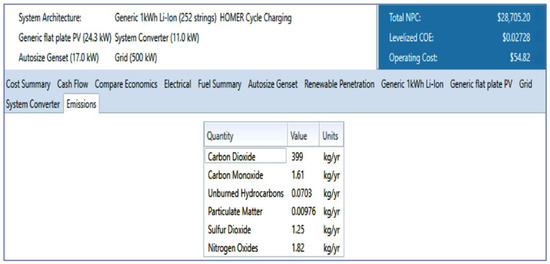
Figure 13.
Emission per annum for the system.
Based on the simulation results, the total PV production in 25 years is 912,158.56 kWh, the total Net Present Cost (NPC) is 28,705.2 USD, and the Levelized Cost of Electricity (LCOE) is $0.02728 per kW-hour.
3.5. Payback Period Calculation
The cost of installing a solar system was $28,705, the 1st year of PV production was 38,866 kWh/year, and the electricity production cost per unit was $0.096 [34]. The total saving per year is determined by the formula below.
Total saving per year = 1st year of PV production × electricity production cost per year
Equation (2) gives the value of total savings per year for this proposed system, as shown below:
= 38,866 × 0.096 = $ 3731.14.
The payback period can be determined by the following equation (Equation (3)):
Equation (3) gives the value of the payback period for this proposed system, as shown below:
4. Conclusions
This paper presents an optimal power system design for the remotely-located healthcare center situated in Baliadangi—Lahiri Hat Rd, Baliadangi, Thakurgaon, Bangladesh, using the HOMER Powering Health Tool. HOMER Pro was used to perform the techno-economic evaluation. The outcomes have elucidated that the hybrid photovoltaic system, consisting of a grid of 24.3 kW PV panels, a 17 kW generator, a net meter, and an 11 kW converter, would be propitious; this is because the outcome of this study showed that it would be the cheapest and most sustainable option, in comparison to the existing traditional power supply in Bangladesh. This study’s major outcomes are listed as follows:
- The grid/PV/generator system was the best combination with the lowest net present cost, because the electricity production cost of the studied system was $0.06/kWh; this was significantly lower than today’s average per-unit cost of $ 0.092 in Bangladesh. Moreover, it had a net present cost of $28,705 and a levelized cost of electricity per kWh of $0.02738.
- In this system, the total electricity production of the hybrid PV system was 912,158.56 kWh in 25 years, whereas the selected health care center might need 612,287.5 kWh in 25 years. The excess power resulting from the system might be sold to the national grid.
- The most significant outcome was the reduction in carbon dioxide emissions, which would have been 16,150 kg/year on the grid but only 399 kg/year with the installation of the system. This means that the installation of this system will significantly aid a reduction in CO2 emissions, which is currently the most important concern for the environment.
- According to the HOMER analysis used in this system, investment expenses will be recovered in 7.7 years.
5. Directions for Further Research
Since PV generation correlates with a lower per-unit cost [30], the collection of electric load-based data for different large-scale private hospitals, in order to analyze the per-unit cost, is in progress. Seepana et al. [35] studied PV system-based hydrogen production and electric vehicle charging stations. In their study, they found that it was possible to reduce CO2 by almost 20,744.04 metric tons. Therefore, in future work, the environmental impact assessment could be studied with the help of Ref. [36] and Seepana et al. [37]. Furthermore, future work could compare and confirm the obtained calculation on a real installation; this will also incorporate the analysis of the economics of a project when using solar modules with an extended service life of up to 40–50 years [38].
Author Contributions
Conceptualization, M.F.R.; methodology, M.F.R.; software, P.A. and M.F.R., validation, M.F.R. and M.K.H.; formal analysis, P.A., M.F.R. and A.K.M.M.H.; investigation, P.A. and M.F.R.; resources, M.F.R.; data curation, P.A. and M.F.R.; writing—original draft preparation, P.A., M.F.R. and A.K.M.M.H.; writing—review and editing, P.A., M.F.R., A.K.M.M.H., M.K.A.M., G.F.I.T., M.H.A., A.K., M.H.K.R. and M.K.H.; visualization, P.A., M.F.R., A.K.M.M.H., M.K.A.M., G.F.I.T., M.H.A., A.K., M.H.K.R. and M.K.H.; supervision, M.F.R. and M.K.H.; project administration, M.F.R. and M.K.H. All authors have read and agreed to the published version of the manuscript.
Funding
This research did not receive any specific grant from funding agencies in the public, commercial, or not-for-profit sectors.
Data Availability Statement
Not applicable.
Conflicts of Interest
The authors declare no conflict of interest.
References
- Islam, A. Health System in Bangladesh: Challenges and Opportunities. Am. J. Health Res. 2014, 2, 366. [Google Scholar] [CrossRef]
- Joarder, T.; Rawal, L.B.; Ahmed, S.M.; Uddin, A.; Evans, T.G. Retaining Doctors in Rural Bangladesh: A Policy Analysis. Int. J. Health Policy Manag. 2018, 7, 847–858. [Google Scholar] [CrossRef]
- Ahmed, S.; Siddique, A.; Iqbal, A.; Rahman, P.N.; Islam, M.N.; Sobhan, M.A.; Islam, M.R.; Sack, R. Causes for Hospitalizations at Upazila Health Complexes in Bangladesh. J. Health Popul. Nutr. 2010, 28, 4. [Google Scholar] [CrossRef]
- Rumi, M.H.; Makhdum, N.; Rashid, M.H.; Muyeed, A. Patients’ Satisfaction on the Service Quality of Upazila Health Complex in Bangladesh. J. Patient Exp. 2021, 8, 237437352110340. [Google Scholar] [CrossRef] [PubMed]
- Islam, M.Z.; Zaman, F.; Farjana, S.; Khanam, S. Accessibility to Health Care Services of Upazila Health Complex: Experience of Rural People. J. Prev. Soc. Med. 2020, 38, 30–37. [Google Scholar] [CrossRef]
- Rahman, M.M.; Saha, S.; Majumder, M.Z.H.; Suki, T.T.; Rahman, M.H.; Akter, F.; Haque, M.A.S.; Hossain, M.K. Energy Conservation of Smart Grid System Using Voltage Reduction Technique and Its Challenges. Evergreen 2022, 9, 924–938. [Google Scholar]
- The World Bank. Access to Modern Energy Services for Health Facilities in Resource-Constrained Settings; The World Bank: Washington, DC, USA, 2018; 94p. [Google Scholar]
- Khan, M.I.; Hossain, M.I.; Hossain, M.K.; Rubel, M.H.K.; Hossain, K.M.; Mahfuz, A.M.U.B.; Anik, M.I. Recent Progress in Nanostructured Smart Drug Delivery Systems for Cancer Therapy: A Review. ACS Appl. Bio Mater. 2022, 5, 971–1012. [Google Scholar] [CrossRef] [PubMed]
- IRENA IOREC 2012 International Off-Grid Renewable Energy Conference. Int. Off-Grid Renew. Energy Conf. 2012. Available online: https://iorec.irena.org/IOREC-2012 (accessed on 22 December 2022).
- Olatomiwa, L.; Blanchard, R.; Mekhilef, S.; Akinyele, D. Hybrid Renewable Energy Supply for Rural Healthcare Facilities: An Approach to Quality Healthcare Delivery. Sustain. Energy Technol. Assess. 2018, 30, 121–138. [Google Scholar] [CrossRef]
- Rojas-Zerpa, J.C.; Yusta, J.M. Application of Multicriteria Decision Methods for Electric Supply Planning in Rural and Remote Areas. Renew. Sustain. Energy Rev. 2015, 52, 557–571. [Google Scholar] [CrossRef]
- Al-Karaghouli, A.; Kazmerski, L.L. Optimization and Life-Cycle Cost of Health Clinic PV System for a Rural Area in Southern Iraq Using HOMER Software. Sol. Energy 2010, 84, 710–714. [Google Scholar] [CrossRef]
- Sharma, S.K.; Palwalia, D.K.; Shrivastava, V. Performance Analysis of Grid-Connected 10.6 KW (Commercial) Solar PV Power Generation System. Appl. Sol. Energy 2019, 55, 269–281. [Google Scholar] [CrossRef]
- Salam, M.A.; Aziz, A.; Alwaeli, A.H.A.; Kazem, H.A. Optimal Sizing of Photovoltaic Systems Using HOMER for Sohar, Oman. Int. J. Renew. Energy Res. 2013, 3, 470–475. [Google Scholar]
- Sultana, M.; Rahman, M.; Das, N.; Ur Rashid, M.M. Feasibility and Techno-Economic Analysis of an Off-Grid Hybrid Energy System: A Char Area in Bangladesh. In Proceedings of the 2021 International Conference on Science & Contemporary Technologies (ICSCT), Dhaka, Bangladesh, 5 August 2021; pp. 1–7. [Google Scholar]
- Adaramola, M.S.; Quansah, D.A.; Agelin-Chaab, M.; Paul, S.S. Multipurpose Renewable Energy Resources Based Hybrid Energy System for Remote Community in Northern Ghana. Sustain. Energy Technol. Assess. 2017, 22, 161–170. [Google Scholar] [CrossRef]
- Hossain, M.K.; Rahman, M.T.; Basher, M.K.; Afzal, M.J.; Bashar, M.S. Impact of Ionizing Radiation Doses on Nanocrystalline TiO2 Layer in DSSC’s Photoanode Film. Results Phys. 2018, 11, 1172–1181. [Google Scholar] [CrossRef]
- Hossain, M.K.; Pervez, M.F.; Tayyaba, S.; Uddin, M.J.; Mortuza, A.A.; Mia, M.N.H.; Manir, M.S.; Karim, M.R.; Khan, M.A. Efficiency Enhancement of Natural Dye Sensitized Solar Cell by Optimizing Electrode Fabrication Parameters. Mater. Sci. 2017, 35, 816–823. [Google Scholar] [CrossRef]
- Hossain, M.K.; Rahman, M.T.; Basher, M.K.; Manir, M.S.; Bashar, M.S. Influence of Thickness Variation of Gamma-Irradiated DSSC Photoanodic TiO2 Film on Structural, Morphological and Optical Properties. Optik 2019, 178, 449–460. [Google Scholar] [CrossRef]
- Aziz, A.S.; Tajuddin, M.F.N.; Adzman, M.R.; Mohammed, M.F.; Ramli, M.A.M. Feasibility Analysis of Grid-Connected and Islanded Operation of a Solar PV Microgrid System: A Case Study of Iraq. Energy 2020, 191, 116591. [Google Scholar] [CrossRef]
- Hossain, M.K.; Raihan, G.A.; Akbar, M.A.; Kabir Rubel, M.H.; Ahmed, M.H.; Khan, M.I.; Hossain, S.; Sen, S.K.; Jalal, M.I.E.; El-Denglawey, A. Current Applications and Future Potential of Rare Earth Oxides in Sustainable Nuclear, Radiation, and Energy Devices: A Review. ACS Appl. Electron. Mater. 2022, 4, 3327–3353. [Google Scholar] [CrossRef]
- Algaddafi, A.; Alshahrani, J.; Diryak, E.; Daho, I. Comparing the Impact of the Off-Grid System and on-Grid System. In Proceedings of the 32nd European Photovoltaic Solar Energy Conference and Exhibition, Munich, Germany, 20–24 June 2016; pp. 2144–2150. [Google Scholar]
- Glaisa, K.A.; Elayeb, M.E.; Shetwan, M.A. Potential of Hybrid System Powering School in Libya. Energy Procedia 2014, 57, 1411–1420. [Google Scholar] [CrossRef]
- Querikiol, E.M.; Taboada, E.B. Performance Evaluation of a Micro Off-Grid Solar Energy Generator for Islandic Agricultural Farm Operations Using HOMER. J. Renew. Energy 2018, 2018, 2828173. [Google Scholar] [CrossRef]
- Aisa, A.; Sharata, A.; Alhkeem Alkhrbash, A.; Almoner, M. Modeling and Simulation of a Hybrid Power System for Hospital in Sabratha, Libya via HOMER Software. In Proceedings of the 2022 IEEE 2nd International Maghreb Meeting of the Conference on Sciences and Techniques of Automatic Control and Computer Engineering (MI-STA), Sabratha City, Libya, 23 May 2022; pp. 161–166. [Google Scholar]
- Baliadangi Upazila Health Complex [Google Maps]. Available online: https://www.google.com/maps/place/@26.127798,88.4666536,7.5z/data=!4m5!3m4!1s0x39e4e6f226d391cf:0x16f75ec6c50c9f78!8m2!3d26.0964047!4d88.276869 (accessed on 1 October 2022).
- Basher, M.K.; Uddin, M.J.; Hossain, M.K.; Akand, M.A.R.; Biswas, S.; Mia, M.N.H.; Shorowordi, K.M. Effect of Doping Profile on Sheet Resistance and Contact Resistance of Monocrystalline Silicon Solar Cells. Mater. Res. Express 2019, 6, 085510. [Google Scholar] [CrossRef]
- Riayatsyah, T.M.I.; Geumpana, T.A.; Fattah, I.M.R.; Rizal, S.; Mahlia, T.M.I. Techno-Economic Analysis and Optimisation of Campus Grid-Connected Hybrid Renewable Energy System Using HOMER Grid. Sustainability 2022, 14, 7735. [Google Scholar] [CrossRef]
- Homer Powering Tool. Available online: https://www.homerenergy.com/ (accessed on 1 October 2022).
- Islam, M.M.M.; Kowsar, A.; Haque, A.K.M.M.; Hossain, M.K.; Ali, M.H.; Rubel, M.H.K.; Rahman, M.F. Techno-Economic Analysis of Hybrid Renewable Energy System for Healthcare Centre in Northwest Bangladesh. Process Integr. Optim. Sustain. 2022. [Google Scholar] [CrossRef]
- Solar, J. Jinko Solar Cheetah HC 72M PV Datasheet. 2008, 2–3. Available online: https://www.jinkosolar.com/uploads/5ee2dd25/Cheetah%20Plus%20brochure.pdf (accessed on 22 December 2022).
- Haratian, M.; Tabibi, P.; Sadeghi, M.; Vaseghi, B.; Poustdouz, A. A Renewable Energy Solution for Stand-Alone Power Generation: A Case Study of KhshU Site-Iran. Renew. Energy 2018, 125, 926–935. [Google Scholar] [CrossRef]
- Shahzad, M.K.; Zahid, A.; ur Rashid, T.; Rehan, M.A.; Ali, M.; Ahmad, M. Techno-Economic Feasibility Analysis of a Solar-Biomass off Grid System for the Electrification of Remote Rural Areas in Pakistan Using HOMER Software. Renew. Energy 2017, 106, 264–273. [Google Scholar] [CrossRef]
- Bangladesh Electricity Prices. Available online: https://www.globalpetrolprices.com/Bangladesh/electricity_prices/ (accessed on 7 June 2022).
- Praveenkumar, S.; Agyekum, E.B.; Kumar, A.; Ampah, J.D.; Afrane, S.; Amjad, F.; Velkin, V.I. Techno-Economics and the Identification of Environmental Barriers to the Development of Concentrated Solar Thermal Power Plants in India. Appl. Sci. 2022, 12, 10400. [Google Scholar] [CrossRef]
- Carbon Footprint Ltd. Carbon Calculator. Available online: https://www.carbonfootprint.com/calculator.aspx (accessed on 1 October 2022).
- Praveenkumar, S.; Agyekum, E.B.; Ampah, J.D.; Afrane, S.; Velkin, V.I.; Mehmood, U.; Awosusi, A.A. Techno-Economic Optimization of PV System for Hydrogen Production and Electric Vehicle Charging Stations under Five Different Climatic Conditions in India. Int. J. Hydrogen Energy 2022, 47, 38087–38105. [Google Scholar] [CrossRef]
- Panchenko, V.; Izmailov, A.; Kharchenko, V.; Lobachevskiy, Y. Photovoltaic Solar Modules of Different Types and Designs for Energy Supply. Int. J. Energy Optim. Eng. 2020, 9, 74–94. [Google Scholar] [CrossRef]
Disclaimer/Publisher’s Note: The statements, opinions and data contained in all publications are solely those of the individual author(s) and contributor(s) and not of MDPI and/or the editor(s). MDPI and/or the editor(s) disclaim responsibility for any injury to people or property resulting from any ideas, methods, instructions or products referred to in the content. |
© 2023 by the authors. Licensee MDPI, Basel, Switzerland. This article is an open access article distributed under the terms and conditions of the Creative Commons Attribution (CC BY) license (https://creativecommons.org/licenses/by/4.0/).